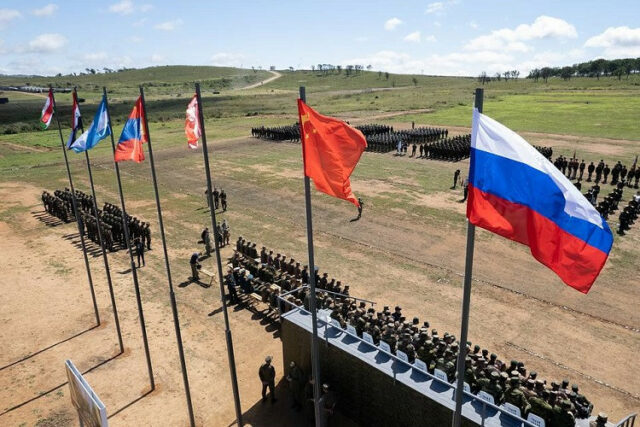
Vostok 2022: Has Russia Learned From Setbacks in Ukraine?
Publication: Eurasia Daily Monitor Volume: 19 Issue: 134
By:

On September 1, the Vostok-2022 military exercises began in Russia’s Far East. Beyond Russian units, the exercises also included military forces from China, India, Belarus, Azerbaijan and Kazakhstan, among others.
The exercises were divided into three main stages (Function.mil.ru, September 6). The first stage involved the capture of an advantageous line. During the exercise, formations and military units entrenched at the line, with the support of artillery and the engineering system for remote mining (ISDM), Agriculture, and in cooperation with a tactical airborne assault, inflicted fire damage on the defending enemy and forbade enemy forces’ organized withdrawal. Combined-arms subunits, together with anti-tank reserves, created conditions for the guaranteed entry into battle of a strike group of troops. Military air defense repelled enemy air attacks, and assault units from 83 separate air assault brigade, based on the experience of operating in modern armed conflicts, captured a settlement occupied by mock enemy units.
During the second stage, to disrupt the system of command and control of the enemy’s troops and to gain fire superiority, a massive strike was inflicted, to which it was planned to involve a group of missile troops and artillery, as well as long-range and operational tactical aircraft.
In the same period, the subunits fighting on the achieved lines continued to inflict fire damage on newly identified targets. The demining installations also began to open passages in the enemy’s minefields. Additionally, the strike group’s formations and military units advanced to the line of transition to prepare for an attack.
The third stage involved a transition to the offensive. The defeat of the mock enemy’s main grouping began with the simultaneous transition of the attack of the strike group’s first echelons with the support of artillery, army aviation and means allocated for direct fire. Covering the advancing troops from enemy attacks, air-to-ground weapons in the formations of combined-arms units were provided through military air defense assets.
After the immediate tasks were completed by the strike group, military contingents from Azerbaijan and Tajikistan began cleaning up the area occupied by the mock enemy, and the units, staffed by citizens arriving from the mobilized human reserves, together with Rosgvardiya units, began consolidating control over the territory and ensured the protection of second-echelon units—mainly responsible for logistics and technical support.
The exercises wrapped up on September 7. In observing the drills, Russian military analysts had expected to witness significant changes in the tactics of the Russian Armed Forces following more than six months of active hostilities in Ukraine, which have revealed many significant problems for Russian forces there. But, in fact, Vostok 2022 exposed the surprising continuity of Moscow’s military strategy.
Indeed, the Russian army is still constructing its tactics according to Soviet textbooks. Armored vehicles continue to be lined up in beautiful, dense rows in the middle of a field, in the same general area as the trenches and air defense systems. Artillery guns are lined up in similar dense rows, and it does not seem to matter whether the systems are self-propelled or towed. Additionally, modern bomber aircrafts still use exclusively unguided free-fall bombs, and helicopters utilize exclusively unguided missiles (T.me/mod_russia, September 5). At the end of such aviation training, even ranks of armored vehicles moved from their positions “on the attack” in less-than-even ranks across an open field without any infantry support. They even took out the ISDM Agriculture from the front. In truth, all these mistakes have led to painful losses and defeats in Ukraine.
It is noteworthy that, among Russian war correspondents, the opinion is shared that, for the sake of the exercises, units of Russian marines were pulled from the front. And the involvement of Rosgvardia units in implementing military operations only reinforces the fact that their failures on the front have not been studied nor fixed by the Kremlin’s military leaders. Indeed, the Rosgvardia units in Ukraine have revealed themselves as the lowest-level units due to the lack of necessary equipment and required training for troops (T.me/zvezdanews, September 6). Of course, one can point out the fact that, for the first time, Chinese troops conducted strategic coordination with Russian ground units, as bombings during the drills were carried out directly by the People’s Liberation Army (PLA) Air Force.
Given the outcomes of the live exercises, it can generally be concluded that the Russian army has learned little during over six months of fighting in Ukraine. And these exercises, in their mass character, were only a faded shadow of the Zapad-2021 drills. In truth, it seems, at times, that the Russian military department does not want to learn and adapt its approach. Yet, in reality, with such an ineffective approach to studying and applying combat experience, the Russian Armed Forces will be doomed to repeat the same mistakes and must overcome the same problems plaguing their forces in Ukraine.
But this synopsis largely concerns the ground exercises. Regarding the naval component, through the joint efforts of the PLA and Russian navies, a number of maneuvers and launches were carried out against possible aircraft carrier formations (T.me/zvezdanews, September 6). This should be interpreted in the context of a potential global military conflict between the United States and China. In this regard, Beijing is counting on Russia’s participation, at best, as a resource appendage and assistant in naval operations (T.me/zvezdanews, September 6).
To be sure, since the Russian army has shown its incompetence in a real war and its inability to implement lessons learned in Ukraine during the Vostok-2022 exercises, China, along with other partners, have lost a great deal of faith in the Russian military establishment.



